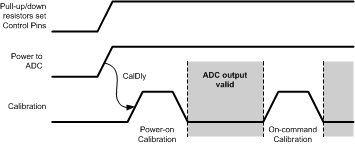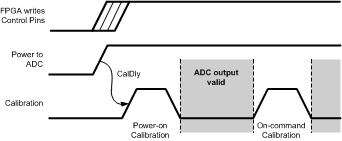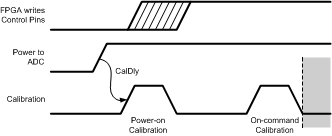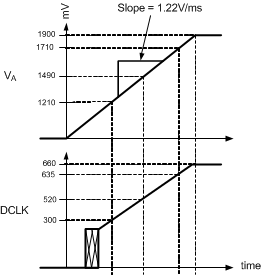SNAS500Q May 2010 – May 2017 ADC12D1800
PRODUCTION DATA.
- 1 Device Overview
- 2 Revision History
- 3 Pin Configuration and Functions
-
4 Specifications
- 4.1 Absolute Maximum Ratings
- 4.2 ESD Ratings
- 4.3 Recommended Operating Conditions
- 4.4 Thermal Information
- 4.5 Converter Electrical Characteristics: Static Converter Characteristics
- 4.6 Converter Electrical Characteristics: Dynamic Converter Characteristics
- 4.7 Converter Electrical Characteristics: Analog Input and Output and Reference Characteristics
- 4.8 Converter Electrical Characteristics: I-Channel to Q-Channel Characteristics
- 4.9 Converter Electrical Characteristics: Sampling Clock Characteristics
- 4.10 Converter Electrical Characteristics: AutoSync Feature Characteristics
- 4.11 Converter Electrical Characteristics: Digital Control and Output Pin Characteristics
- 4.12 Converter Electrical Characteristics: Power Supply Characteristics
- 4.13 Converter Electrical Characteristics: AC Electrical Characteristics
- 4.14 Converter Timing Requirements: Serial Port Interface
- 4.15 Converter Switching Characteristics: Calibration
- 4.16 Typical Characteristics
-
5 Detailed Description
- 5.1 Overview
- 5.2 Functional Block Diagram
- 5.3 Feature Description
- 5.4 Device Functional Modes
- 5.5
Programming
- 5.5.1
Control Modes
- 5.5.1.1
Non-Extended Control Mode
- 5.5.1.1.1 Dual Edge Sampling Pin (DES)
- 5.5.1.1.2 Non-Demultiplexed Mode Pin (NDM)
- 5.5.1.1.3 Dual Data Rate Phase Pin (DDRPh)
- 5.5.1.1.4 Calibration Pin (CAL)
- 5.5.1.1.5 Calibration Delay Pin (CalDly)
- 5.5.1.1.6 Power Down I-channel Pin (PDI)
- 5.5.1.1.7 Power Down Q-channel Pin (PDQ)
- 5.5.1.1.8 Test Pattern Mode Pin (TPM)
- 5.5.1.1.9 Full-Scale Input Range Pin (FSR)
- 5.5.1.1.10 AC/DC-Coupled Mode Pin (VCMO)
- 5.5.1.1.11 LVDS Output Common-mode Pin (VBG)
- 5.5.1.2 Extended Control Mode
- 5.5.1.1
Non-Extended Control Mode
- 5.5.1
Control Modes
- 5.6 Register Maps
- 6 Application and Implementation
- 7 Power Supply Recommendations
- 8 Layout
- 9 Device and Documentation Support
- 10Mechanical, Packaging, and Orderable Information
Package Options
Mechanical Data (Package|Pins)
- NXA|292
Thermal pad, mechanical data (Package|Pins)
Orderable Information
7 Power Supply Recommendations
7.1 System Power-on Considerations
There are a couple important topics to consider associated with the system power-on event including configuration and calibration, and the Data Clock.
7.1.1 Power-on, Configuration, and Calibration
Following the application of power to the ADC12D1800, several events must take place before the output from the ADC12D1800 is valid and at full performance; at least one full calibration must be executed with the device configured in the desired mode.
Following the application of power to the ADC12D1800, there is a delay of tCalDly and then the Power-on Calibration is executed. This is why it is recommended to set the CalDly Pin via an external pull-up or pull-down resistor. This ensured that the state of that input will be properly set at the same time that power is applied to the ADC and tCalDly will be a known quantity. For the purpose of this section, it is assumed that CalDly is set as recommended.
The Control Bits or Pins must be set or written to configure the ADC12D1800 in the desired mode. This must take place via either Extended Control Mode or Non-ECM (Pin Control Mode) before subsequent calibrations will yield an output at full performance in that mode. Some examples of modes include DES/Non-DES Mode, Demux/Non-demux Mode, and Full-Scale Range.
The simplest case is when device is in Non-ECM and the Control Pins are set by pull-up/down resistors, see Figure 7-1. For this case, the settings to the Control Pins ramp concurrently to the ADC voltage. Following the delay of tCalDly and the calibration execution time, tCAL, the output of the ADC12D1800 is valid and at full performance. If it takes longer than tCalDly for the system to stabilize at its operating temperature, it is recommended to execute an on-command calibration at that time.
Another case is when the FPGA configures the Control Pins (Non-ECM) or writes to the SPI (ECM), see Figure 7-2. It is always necessary to comply with the Section 4.3 and Section 4.1; for example, the Control Pins may not be driven below the ground or above the supply, regardless of what the voltage currently applied to the supply is. Therefore, it is not recommended to write to the Control Pins or SPI before power is applied to the ADC12D1800. As long as the FPGA has completed writing to the Control Pins or SPI, the Power-on Calibration will result in a valid output at full performance. Once again, if it takes longer than tCalDly for the system to stabilize at its operating temperature, it is recommended to execute an on-command calibration at that time.
Due to system requirements, it may not be possible for the FPGA to write to the Control Pins or SPI before the Power-on Calibration takes place, see Figure 7-3. It is not critical to configure the device before the Power-on Calibration, but it is critical to realize that the output for such a case is not at its full performance. Following an On-command Calibration, the device will be at its full performance.
 Figure 7-1 Power-on with Control Pins set by Pull-up/down Resistors
Figure 7-1 Power-on with Control Pins set by Pull-up/down Resistors
 Figure 7-2 Power-on with Control Pins set by FPGA pre Power-on Cal
Figure 7-2 Power-on with Control Pins set by FPGA pre Power-on Cal
 Figure 7-3 Power-on with Control Pins set by FPGA post Power-on Cal
Figure 7-3 Power-on with Control Pins set by FPGA post Power-on Cal
7.1.2 Power-on and Data Clock (DCLK)
Many applications use the DCLK output for a system clock. For the ADC12D1800, each I- and Q-channel has its own DCLKI and DCLKQ, respectively. The DCLK output is always active, unless that channel is powered-down or the DCLK Reset feature is used while the device is in Demux Mode. As the supply to the ADC12D1800 ramps, the DCLK also comes up, see this example from the ADC12D1800RB: Figure 7-4. While the supply is too low, there is no output at DCLK. As the supply continues to ramp, DCLK functions intermittently with irregular frequency, but the amplitude continues to track with the supply. Much below the low end of operating supply range of the ADC12D1800, the DCLK is already fully operational.
 Figure 7-4 Supply and DCLK Ramping
Figure 7-4 Supply and DCLK Ramping